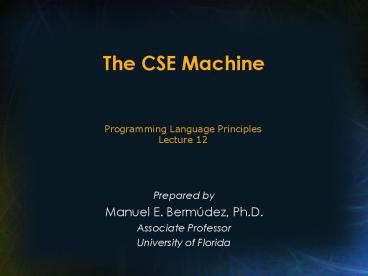The CSE Machine - PowerPoint PPT Presentation
1 / 22
Title:
The CSE Machine
Description:
Substitution mechanism (based on lambda-calculus) convenient for humans, but ... rand = pop(stack) push(apply(rator,rand), stack) ... – PowerPoint PPT presentation
Number of Views:45
Avg rating:3.0/5.0
Title: The CSE Machine
1
The CSE Machine
Programming Language Principles Lecture 12
- Prepared by
- Manuel E. Bermúdez, Ph.D.
- Associate Professor
- University of Florida
2
Mechanical Evaluation of RPAL Programs
- Substitution mechanism (based on lambda-calculus)
convenient for humans, but inconvenient for
machines. - Need an algorithm to complete the operational
semantic specification of RPAL
3
Introducing the CSE Machine
- C - Control
- a sequence of operations
- S - Stack
- operands
- E - Environment
- Initially, PE (Primitive Environment)
- Updated as evaluation proceeds
- PE a mapping from names to objects and
operations.
4
CSE Machine programs control structures
- Flatten the RPAL program's ST into a "control
structure
(vs. a lambda-expression). - Done using a simple pre-order tree traversal.
5
Example
- Evaluate -2 (a-b), in an environment in which
(somehow) a6 and b1. - Flattened control structure ? neg ? ? 2 ? ?
- a b. - Place this control structure on the Control of
the CSE Machine.
6
(No Transcript)
7
CSE Machine Operation (informally)
- Remove right-most item from control.
- If a name, look it up in the CE (current
environment), push onto the stack. - If ?, then
- rator pop(stack)
- rand pop(stack)
- push(apply(rator,rand), stack)
- Stop if control is empty value on the stack is
the result.
8
Notes
- Minus function that subtracts its second
argument from its first one. - Minus6 a function that subtracts its argument
from 6. - Exp, likewise the exponentiation function.
- Exp2 function that raises 2 to the power of its
argument.
9
Notes (contd)
- Notice difference between "neg" (a name), and
"Neg" (the actual operator). - Control contains gammas (and lambdas) and names.
Stack contains "real" values.
10
Generating Control Structures
- Begin with CS (control structure) ?0
- Perform a pre-order traversal of the
standardized tree. - For each node
- If a name, add it to the current CS.
- If a ?, add it to the current CS.
- If a ?, add lt? k xgt to the current CS.
- k new index x ?'s left child.
- Generate control structure ?k traverse the ?'s
right child.
11
Generating Control Structures
- We use a single symbol to represent a ?
-expression, both on the control, and on the
stack. The symbol is lti ? k xgt. - i environment,
- k CS of the function's body,
- x the function's bound variable.
- The ? -expression becomes a ? -closure when its
environment is determined, when it is placed on
the stack.
12
Examples
- Three examples of generating control structures.
13
(No Transcript)
14
(No Transcript)
15
(No Transcript)
16
Operation of the CSE Machine
- Five rules
- Process driven by TOP symbol on the control.
- Need environment markers, on the Control and
Stack. - Every environment is linked to a previously
created (but not necessarily currently active)
environment. - Thus, environment structure is a tree.
17
(No Transcript)
18
Examples of CSE Machine Operation
- Lets run through the CSE machine, for our 3
examples.
19
(No Transcript)
20
(No Transcript)
21
(No Transcript)
22
The CSE Machine
Programming Language Principles Lecture 12
- Prepared by
- Manuel E. Bermúdez, Ph.D.
- Associate Professor
- University of Florida






























